Koryo Books: Where K-Pop Fans and Book Lovers Converge in NYC
Established over 40 years ago, this Koreatown store has evolved from a community bookshop into a global cultural destination!


Every year, the 9/11 Memorial at the World Trade Center is the site of the annual commemoration in honor of those who lost their lives in the 2001 terrorist attacks on the Twin Towers. But if you’re looking to mark 9/11 for yourself without necessarily going to the memorial site, there are many other 9/11 memorials all around New York City. In many of these, you can pay your respects and view a live historical artifact from that somber day.
The World Trade Center site looks nothing like it did five or ten years ago; heaps and tons of metal have been removed from the wreckage. These artifacts were stored in the 80,000 square-foot Hangar 17 in John F. Kennedy Airport, where they were cut and sorted to be sent out, filling hundreds of requests from around the world to have a piece of the hallowed material for shrines and memorials, even as far as New Zealand.
The 9/11 Memorial Museum at the World Trade Center is also a repository for many more artifacts, giving visitors a chance to learn even more about the buildings that once stood at that very place. But even if you haven’t gotten to the museum yet, here are some of our favorite other 9/11 memorials from public spaces, parks, to memorial sites where you can find a real piece of the original towers, or simply pay your respects.
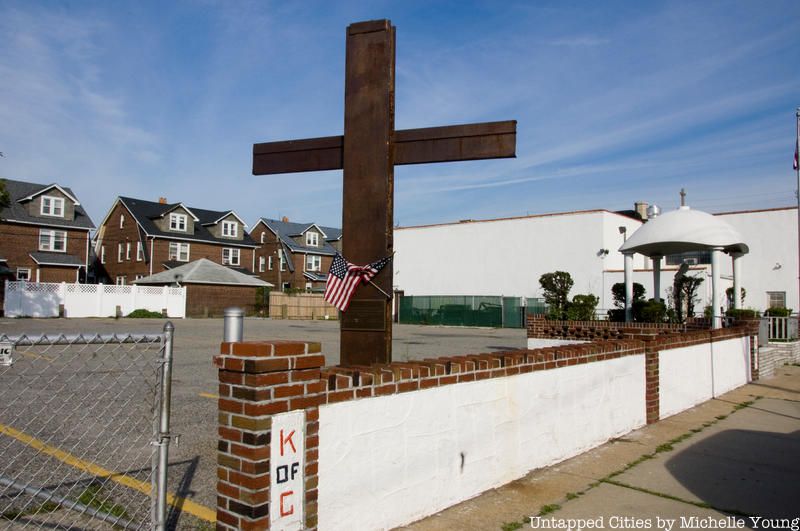
This World Trade Center remnant is located in a parking lot in Rockaway Beach, Queens. It may be in a seemingly random spot, but it invokes the memory of September 11th nonetheless, especially as it is visually similar to the Ground Zero Cross. It was donated by the New York City Department of Sanitation to the local Knights of Columbus chapter and erected at the site on Beach 90th close to Jamaica Bay.

This work, entitled Postcards, is located on the North Shore Waterfront Esplanade on Staten Island. By architect Masayuki Sono, the wing-like structures also feature 274 plaques with those lost on 9/11. The sculpture is oriented exactly towards where the Twin Towers once stood – stand between the two wings when you visit.
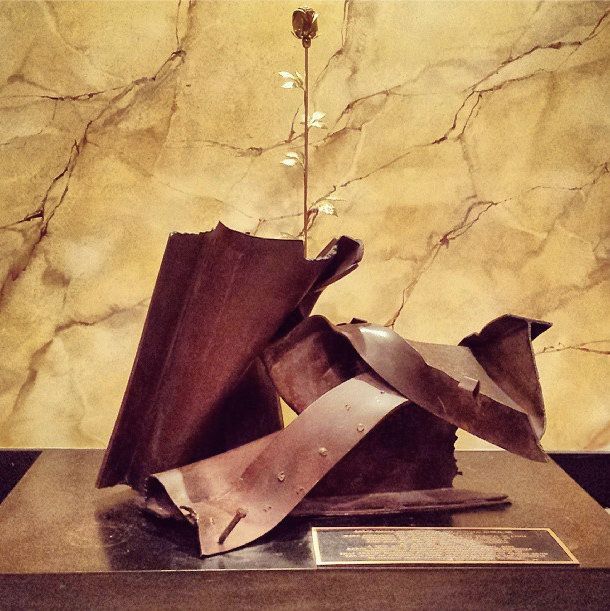
Photo by g1g1_nyc
These little known 9/11 Memorials are located inside the Church of St. Francis of Assisi on 31st Street between 6th and 7th Avenue. Three pieces of steel recovered from the World Trade Center site are displayed in front of a stained glass window commemorating those lost, which included Friar Michael Judge, chaplain of the FDNY and Carol LaPlante, a secular Franciscan.

Seen clearly from the Hudson River, the Teardrop Memorial in Bayonne, New Jersey stands in a small park cut out of an industrial area. Its official name is “To the Struggle Against World Terrorism”, the 10-story bronze-plated monument is actually a gift from Russia in memory of the victims of terrorism in both the 9/11 attacks and the 1993 bombing. It was built in 2006 and designed by Russian artist Zurab Tsereteli.
As per its nickname, a teardrop made out of nickel hangs from the top of the sculpture between the jagged edges cut out from the monument. Granite plates bear the etched names of the victims of both terrorist attacks.
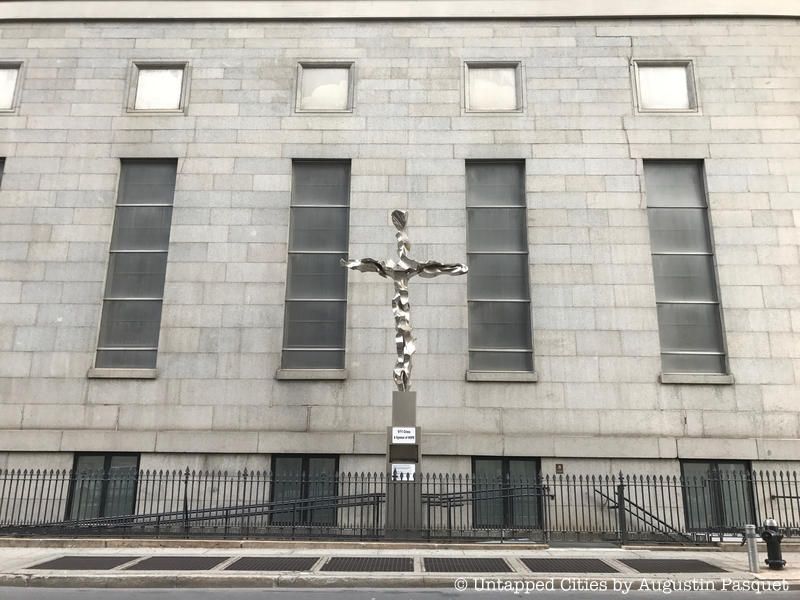
The iconic “Ground Zero Cross,” a group of steel beams in the shape of a cross from the rubble of the World Trade Center, was quite possibly the very first shrine after the attacks. From around the time it was found at Ground Zero, those with access used the cross as a place to leave flowers, notes, and pictures of loved ones. As the site was being cleared, the cross was moved to St. Peter’s Roman Catholic Church, which faces Ground Zero. When the new 9/11 Memorial Museum opened, it was relocated as part of the museum’s exhibits but a new cross was installed there.

Skanksa built both the original World Trade Center and the new Transportation Hub, designed by Santiago Calatrava. In the new station, there was a deliberate move to also remember what happened on 9/11. To that end, the design has made visible the sections of the original steel framework and concrete foundation of the Twin Towers. You can see these sections under glass on the platform of the PATH station.

Look closely at the intricate stone facade of the Cathedral of St. John the Divine. At the Portal of Paradise, on the Cathedral’s western facade, the pillars hold scenes of destruction of New York. Added to the cathedral by stone carver Simon Verity between 1988 and 1997, the scenes include the Brooklyn Bridge and the Statue of Liberty collapsing or sinking, and prophetically, the Twin Towers in a cloud of destruction. But there are also images of rebirth, with the depiction of stonemasons building a great cathedral on the city’s ashes.

The 69th Infantry Regiment, popularly known as the “Fighting Irish,” were one of the first responders at 9/11, going in against orders. A piece of steel is framed inside the Garryowen Club, a private bar in the infantry’s regiment on Lexington Avenue.
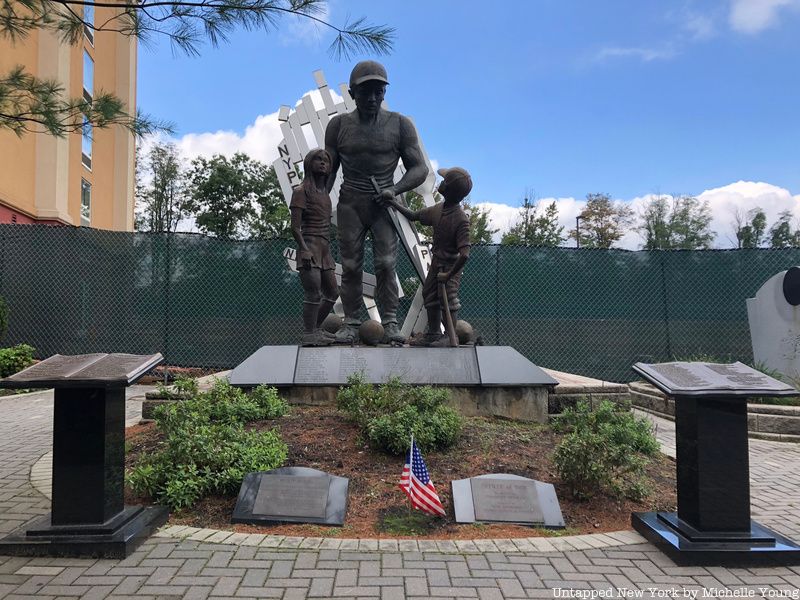
Located in the Staten Island Corporate Park in Bloomfield, Staten Island down a real-life Lois Lane, this little-known memorial entitled the Spirit of 9/11 was sculpted by Gregory Perillo. A plaque states that the work was inspired by Bob Johnson and the United Sports Alliance, and indeed, the figures show a man with a hockey stick with two youngsters, one holding a baseball, the other standing in front of a soccer ball. Behind the statues is a recreation of a fragment of the World Trade Center facade with the acronyms of the first responders on it: FDNY, EMS, PAPD, and NYPD.
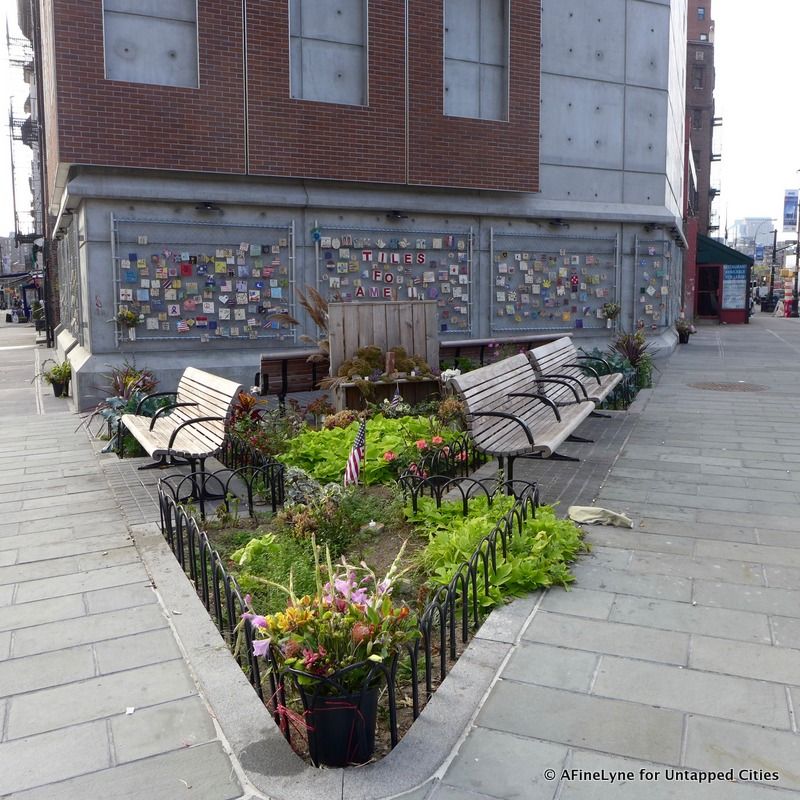
Tiles for America is an installation created after 9/11 by artists and local Greenwich Village residents, who spontaneously placed the works on a chain-link fence that surrounded an empty MTA lot. It became a gathering place for the people in the community, with additional tiles adorning the fence over the years. When the new MTA ventilation building was completed (looking like a fake townhouse), the Tiles for America were permanently reinstalled on the three walls of the new structure.
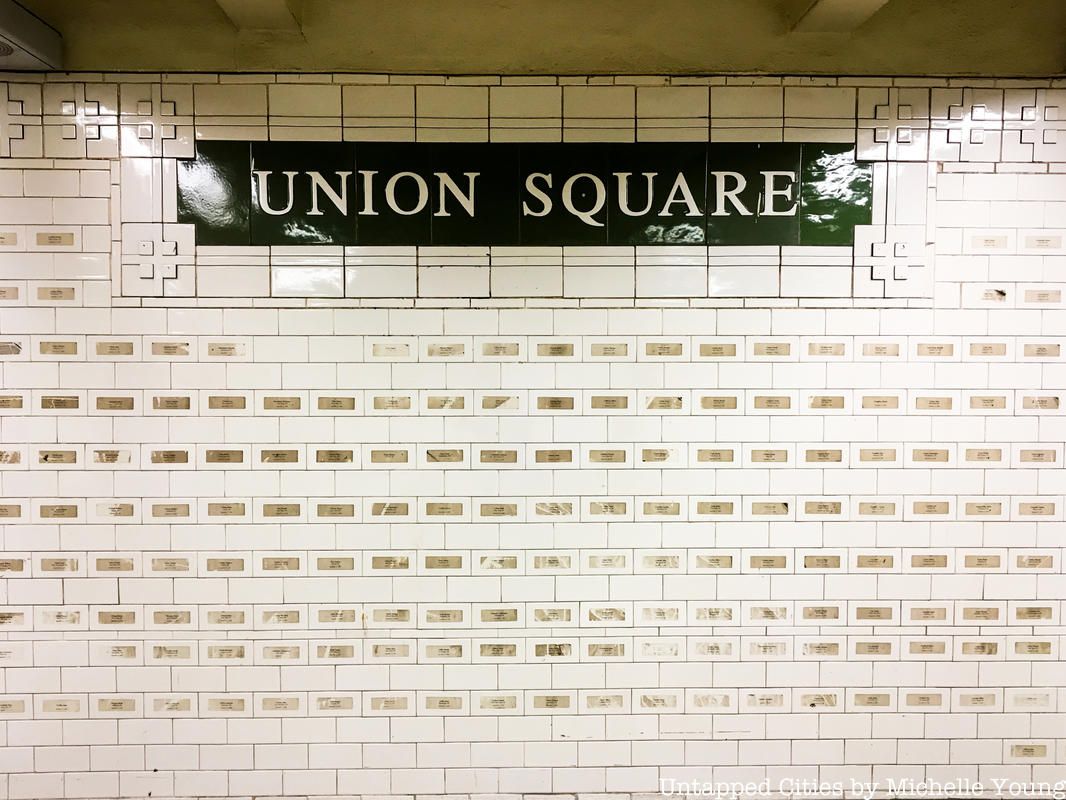
On the white subway tiles in the Union Square subway station are over 3,000 stickers, each with the name of a 9/11 victim and where they lived. This spontaneous memorial was placed on the night of September 10, 2002 with John Lin and sixteen friends went to the subway station and pasted the transparent mailing labels on the tiled wall. The MTA left the memorial in place, although after so many years the stickers are deteriorating. Lin told us that they chose Union Square because for a period fo time, it was the furthest south the public was allowed to go, so it was the site of many vigils and gatherings. Second, the New York City subway is at the heart of the city, and it would be protected indoors, and finally, there was a police station at the station nearby in the subway station, a reminder of 9/11’s first responders.

Although the Firefighter’s Memorial, located at 100th Street and Riverside Drive, was dedicated in 1913. For nearly two decades, it has served as a place for families and fellow firefighters to remember the 343 comrades who perished on September 11th 2001.
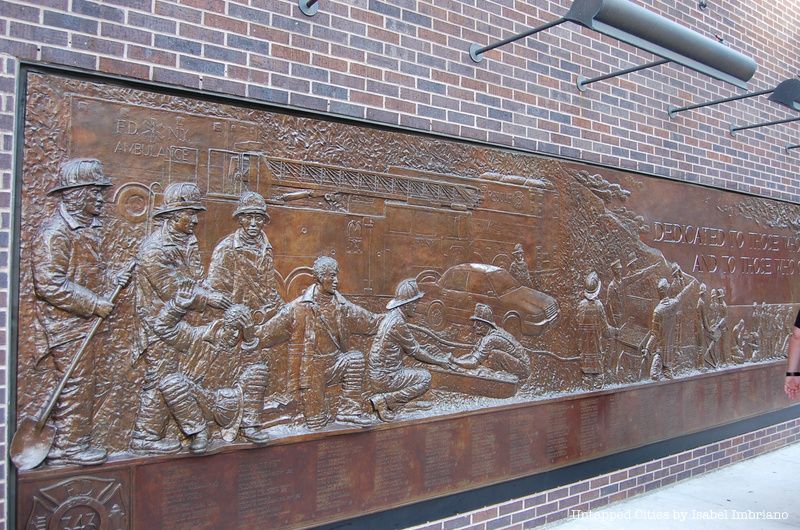
Close to the World Trade Center site is the ladder company of some of the very first responders. Firefighters from Ladder & Engine 10 who gave their lives on September 11th are immortalized on this 56-foot bronze sculpture, a common stop for visitors on their way to see 1 WTC and other parts of Memorial Plaza.

The Sphere is a bronze sculpture by Fritz Koenig that once stood in the Tobin Plaza between the Twin Towers at the World Trade Center. After the attacks on September 11th, the Sphere was recovered from the rubble and relocated to Battery Park near the Hope Garden but was moved back in 2017 to the World Trade Center site at Liberty Park. It accompanies an Eternal Flame that was lit on the first anniversary of the attacks. The plaque reads: “It was damaged during the tragic events of 11 September 2001, but endures as an icon of hope and the indestructible spirit of this country. The Sphere was placed here on 11 March 2002 as a temporary memorial to all who lost their lives in the terrorist attacks at the World Trade Center.”

America’s Response Monument, located Liberty Park next to the World Trade Center honors those in the American armed forces that served in response to 9/11. The monument contains a fragment of steel from the World Trade Center and was commissioned anonymously by a group of Wall Street bankers who had lost friends in 9/11.

Inside the lesser-known NYC Fire Museum are numerous relics from the World Trade Center attacks, including fire engine signs, steel from the buildings, helmets and gear from fallen firemen, and Nikon camera that had been lost and recovered, with all the photos intact.https://untap.nyc/3aFP0Gh

Within the Memorial Plaza, where visitors can view the reflecting pools at the current World Trade Center Memorial, stands the Survivor Tree, which we’ve covered before. It is a Callery pear tree that survived the attacks on 9/11, and was worked into the design of the Memorial Plaza. Workers managed to free it and nurse it back to health in a Bronx park before replanting it again in Memorial Plaza. Survivor Tree, now standing at about thirty feet, approximately four times its original height back in 2001, easily towers over the other trees planted in the Plaza. Visitors flock around the tree–a living and breathing reminder that we must grow and move forward after these events, as its limbs bear the scars of the Towers.

An important part of the 9/11 memorial ceremonies is the Tribute in Light. On the night of September 11th every year (so far), an art installation of 88 searchlights is set up in Ground Zero and flashed toward the sky as a tribute of the towers that once stood. This year’s lights will turn on at sunset on 9/11, ending sunrise the next day. These lights can be seen from as far as 60 miles away on a clear night, a beacon to all those who were affected by the attacks. The tribute has seen a lot of controversy, including several termination dates and this year’s averted cancellation, but ultimately the installation remains a major spectacle of New York City’s ceremonies on this date. We previously went behind-the-scenes into the installation of the famous lights, with photos here.

On September 11, 2016, two PATH cars from the train that was found beneath the World Trade Center site opened to the public for the first time at two different trolley museums: The Shore Line Trolley Museum and the Kingston Trolley Museum. This PATH train was ordered to be evacuated before the Twin Towers fell. Most of the train was found destroyed, but two cars remained intact and were given to the two trolley museums in 2015.
Subscribe to our newsletter